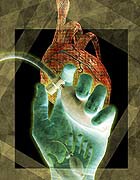- Double Mastectomy May Offer No Survival Benefit to Women With Breast Cancer
- Toxic Lead Found in Cinnamon Product, FDA Says
- Certain Abbott Blood Sugar Monitors May Give Incorrect Readings
- Athletes Can Expect High Ozone, Pollen Counts for Paris Olympics
- Fake Oxycontin Pills Widespread and Potentially Deadly: Report
- Shingles Vaccine Could Lower Dementia Risk
- Your Odds for Accidental Gun Death Rise Greatly in Certain States
- Kids From Poorer Families Less Likely to Survive Cancer
- Tough Workouts Won’t Trigger Cardiac Arrest in Folks With Long QT Syndrome
- At-Home Colon Cancer Test Can Save Lives
‘Smart’ Pacemakers May Protect Heart From Further Damage


A “smart” pacemaker that kicks in only when a person’s heartbeat becomes irregular can be more effective in preventing further heart damage than standard pacemakers that are always at work, researchers report.
These highly programmed pacemakers reduced by 26 percent patients’ risk of death, hospitalization for heart disease and permanent irregular heartbeat, according to late-breaking research presented Monday at the American Heart Association annual meeting in Dallas.
“The more sophisticated pacemaker technology proved to be superior to the current standard of care,” said study co-author Dr. Giuseppe Boriani, a professor at the Institute of Cardiology at the University of Bologna, Italy.
Standard pacemakers are used to continually regulate the heartbeat in people with bradycardia, a condition in which the heart beats slower than 60 beats per minute.
More than 128,000 people in the United States suffer from irregular heartbeat problems like bradycardia, and those cases account for about half the pacemakers implanted in the United States, Boriani said.
But the old-style pacemakers and their constant stimulation increase a person’s risk of one of bradycardia’s common complications, a rapid and irregular beating of the heart’s upper chambers known as atrial fibrillation.
Heart patients with atrial fibrillation run a higher risk of heart failure, stroke and death.
Doctors have been experimenting with different methods to use pacemakers to stimulate the heart’s upper chambers (the atria) and the heart’s lower chambers (the ventricles) in a way that prevents atrial fibrillation.
This study focused on 1,166 patients who received pacemakers programmed in one of three different ways:
- One program performed standard pace making, which sends electrical pulses to both chambers of the heart.
- Another focused on pace making that would stimulate both the atria and the ventricles if the pacemaker sensed that an episode of atrial fibrillation was imminent.
- The third combined that second approach with an additional feature: a number of different programs that stimulated the atria to both head off an irregular heartbeat and to restore normal heart rhythm.
The third program, which focused on a varied, off-and-on approach to the whole heart, was superior to the other two. By the end of the two-year study, it had reduced by 61 percent the number of heart patients who developed permanent atrial fibrillation.
Over the next two years, just over 15 percent of those with smart pacemakers were hospitalized and 4.6 percent died, compared to nearly 17 percent hospitalizations and 5.6 percent deaths for those without smart pacemakers.
The patients provided with smart pacemakers also reported that they felt less fatigue and enjoyed better quality of life.
This breakthrough came after a couple of dozen studies of different pacemaker programs that had shown no benefit, said Dr. Anthony Tang, a professor of medicine at Western University Canada in Ontario.
“It was a bit disappointing that it didn’t universally show positive effect,” Tang said of previous research. In this study, doctors appear to have figured out the best programs that will cause the pacemaker to kick in at the right time and for the appropriate heart chamber.
Boriani said this sort of pacemaker programming should be further evaluated.
“If applied to all patients requiring pacemakers, the benefits could help many thousands of patients in every country,” he said.
The research was funded by Medtronic, a pacemaker company that provided the pacemakers used in the study.
Research presented at meetings should be considered preliminary until published in a peer-reviewed medical journal.
More information
Visit the American Heart Association for more on heart pacemakers.
Source: HealthDay
Copyright © 2024 HealthDay. All rights reserved.










